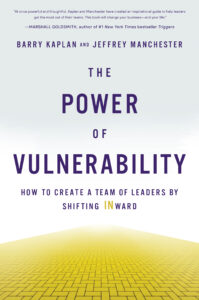Step Back
It may be counterintuitive, but according to Barry Kaplan and Jeff Manchester — who have decades of experience as entrepreneurs and advisers to hundreds of companies — the the best way to lead is to step back. The more that you as a leader open your heart, reveal your fears and show your authentic self, the deeper the connections among your team members will be, and the more the team will achieve.
Partners at Shift180, Barry and Jeff present their unique approach to maximizing performance in their new book, The Power of Vulnerability: How to Create a Team of Leaders by Shifting Inward. I recently spoke with them after reading the book, to talk about their views on leadership culture and vulnerability.
Understand the Power of Vulnerability
Why is vulnerability misunderstood?
We are taught and then hard-wired to believe that showing vulnerability is a weakness. The fear, of course, is that if we demonstrate vulnerability, others will be able to take advantage of us. This, however, is far from the truth. The reality is that, by sharing our vulnerability, we lay the groundwork for truly connecting with others – which is incredibly powerful. We need to relearn that vulnerability is gateway to authenticity, connection and ultimately power.
When is it wrong to be vulnerable and can you be too vulnerable?
Despite the power vulnerability can bring, if you’re not in a safe environment where you can leverage its power, exhibiting vulnerability may be a mistake. Safety is a necessary predicate to being able to open up, show up and co-create trust.
In what ways can a leader create an environment of safety to allow team members to be vulnerable?
Leaders play a key role in creating this safe space, particularly by role modeling. As a leader, it is up to you to step in first. Show up with your real story that will disrupt the typical pattern of hiding behind the veil. By taking action, you are giving your team a real case-study of how — and more importantly, why — it works.
I love this quote in your book: “Your depth of connection with the team will mirror the depth of your connection with yourself.” Most business leaders are focused on the numbers, analytics, etc. What are some ways to create time to connect with yourself on a regular basis?
You should consciously make team connections a critical priority. Include them in every interaction, from 5-minute huddles (one-word check-ins), to regular leadership meetings (5-minute-check-ins and clearings) to scheduling quarterly or at least annual offsite meetings (more time for deeper dives). These interactions provide a regular rhythm to anchor and integrate the emerging connections by, between and among the members of the team, which ultimately co-create a team built deeply connected through mutual trust.
Always Be Authentic
Authenticity is closely related to vulnerability. How does a leader encourage each member to be more authentic?
They key is to be authentic yourself. Share how you feel and tell your team why it’s significant and what the impact will be to the business. When your team members connect with you, they will be your advocates, and will be more likely to also show their own vulnerability.
For example, if you learn why a teammate is so terrified by public speaking (perhaps she was humiliated on stage when she was in a high school play and lost her lines), you will likely empathetically connect with her fear, and be drawn to support and advocate for her when she faces that inner fear in her next public presentation.
You have so many powerful examples throughout this book. Would you share an example of the power of vulnerability?
Sure. One of the stories that truly resonates involves an automotive retailer we worked with. We were conducting a three-day retreat with the CEO and his team. In our typical fashion, we started by inviting the participants to get present by checking in with what was on their mind, and how they were feeling. The CEO began by speaking vulnerably about his deep, profound fears and the magnitude of his hope that the team would make it out of the recession. He shared that he was afraid of losing the company and the impact this would have on others. He was afraid of disappointing his family and all of the families he had touched through the workforce. He spoke about his worry that one of his bookkeepers, who was suffering from a chronic disease, would lose her health insurance. Then, his energy shifted a bit as he raised his head and spoke to his belief that the company would make it as long as everyone held on to the core purpose of why he started the business—the ideal “that every person matters.”
The other team members immediately connected with his fears and were in awe of his ability to also grasp his hope. His authenticity set the stage for all of the content that ultimately cascaded from the minds and hearts of the team. Suddenly, the accounting manager volunteered to help a Marketing VP with a client problem that had been looming for too long, and two coworkers, recently divorced (though neither had known about the other before the retreat), became supports for each other. That check-in exercise inspired the group to move from a circle of coworkers to a team of fellow human beings who deeply felt each other’s pains and aspirations. The authentic connections bound them together in a winning belief and spirit for themselves and each other.
By being vulnerable in that moment, the CEO began what was a pivotal year of fighting back—not just to survive but ultimately to thrive.
You share your concept of INpowerment. Tell us more about it and how leaders can embrace it.
Not to be confused with empowerment, INpowerment comes from our beliefs that:
- each individual and team has more power than we realize,
- each of us has the capacity to access the power inside us,
- we can learn how to do it,
- we can do it on our own, but even better as a team, and
- we need to discover and unleash that power by shifting inward.
The potential of INpowerment reaches beyond our imaginations, yet it requires the courage of vulnerability to join the journey.
While the power resides inside to crack open its potential, you need to take the first step inward to that field of power through an uncomfortable act of sharing, disclosure or revealing that calls for courage.
Show Up Inpowered
How does a leader encourage individuals to show up INpowered?
It comes down to creating a safe environment to be vulnerable through role modeling. This will start a mindset shift of open sharing, inviting the interplay of creative tensions and a culture of innovation.
When you see a fully INpowered leader, what do you notice about him or her that stands out?
The leader appears authentic and ‘comfortable in her own skin’ – perfectly embracing her whole self, including all that she used to hide. You can see beauty underneath the imperfections in a way that helps you to reframe your definition of perfect—as if those raw vulnerabilities help the clear strengths shine. You are drawn to her field of energy because of her presence and message.
For more information, see The Power of Vulnerability: How to Create a Team of Leaders by Shifting Inward.

